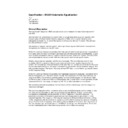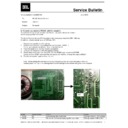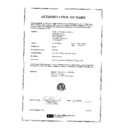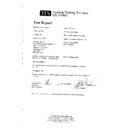Read JBL TiK SUB User Guide / Operation Manual online
Ti K SUB
O W N E R ’ S M A N U A L
B E T R I E B S A N L E I T U N G
MANUEL D’UTILISATION
INTRODUCTION
Thank you for choosing the JBL TiK Sub designed to produce
extended, powerful deep bass in any high performance music or
home cinema system. While created as an integral part of the
acclaimed JBL TiK loudspeaker range, the TiK Sub is also fully
compatible with any make or model of high quality main/satellite
loudspeakers for state of the art stereo and surround audio.
extended, powerful deep bass in any high performance music or
home cinema system. While created as an integral part of the
acclaimed JBL TiK loudspeaker range, the TiK Sub is also fully
compatible with any make or model of high quality main/satellite
loudspeakers for state of the art stereo and surround audio.
To ensure correct installation and optimum performance, please
take the time to thoroughly read and follow the instructions in this
owner’s manual.
take the time to thoroughly read and follow the instructions in this
owner’s manual.
UNPACKING
The packing materials are designed to protect the subwoofer from
damage during shipment. We advise you to keep the packing
materials for future use.
damage during shipment. We advise you to keep the packing
materials for future use.
PLACEMENT
Always start with the subwoofer as close to one of the front corners
as possible. It is also recommended that the subwoofer be
positioned along the same wall as the front loudspeakers. Corner
placement provides substantial bass reinforcement. Placement away
from corners, near a single wall offers some reinforcement, while
placement away from walls offers minimal bass reinforcement.
as possible. It is also recommended that the subwoofer be
positioned along the same wall as the front loudspeakers. Corner
placement provides substantial bass reinforcement. Placement away
from corners, near a single wall offers some reinforcement, while
placement away from walls offers minimal bass reinforcement.
If bass response is excessive, use the subwoofer’s Level control to
reduce bass output. If excessive bass is limited to a few specific
frequencies, it may be necessary to modify the acoustical coupling
of the subwoofer to the room boundaries and/or to the room modes
by moving the subwoofer to a location which provides more evenly
balanced bass response.
reduce bass output. If excessive bass is limited to a few specific
frequencies, it may be necessary to modify the acoustical coupling
of the subwoofer to the room boundaries and/or to the room modes
by moving the subwoofer to a location which provides more evenly
balanced bass response.
CONNECTION
The TiK Sub can be connected to your audio system using either
line level or speaker level connections. Do not use both at the same
time. If available, use line level connection.
line level or speaker level connections. Do not use both at the same
time. If available, use line level connection.
The TiK Sub also includes a special balanced XLR DSP In. This
connection may be used (with the Input Select switch not pressed
in) as a conventional balanced connection, if your receiver/amplifier
has a balanced subwoofer output. With the Input Select switch
pressed in, this socket may only be used to connect the subwoofer
to a JBL TiK Master Sub.
connection may be used (with the Input Select switch not pressed
in) as a conventional balanced connection, if your receiver/amplifier
has a balanced subwoofer output. With the Input Select switch
pressed in, this socket may only be used to connect the subwoofer
to a JBL TiK Master Sub.
Note: The push-button controls on the rear of the subwoofer are
recessed into the rear panel to prevent accidentally activating an
unwanted function. To push a button, use a small pointed object
such as a pencil, screwdriver, etc.
recessed into the rear panel to prevent accidentally activating an
unwanted function. To push a button, use a small pointed object
such as a pencil, screwdriver, etc.
JBL TiK Sub Owner’s Manual
ENGLISH
Line Level
If your receiver/amplifier has subwoofer outputs or preamp outputs
for the left and right channels, connect them to the Line In Left and
Right sockets on the subwoofer. If your receiver/amplifier has a
single mono subwoofer output, it can be connected to either the
subwoofer’s Line In Left or Right. Use of a single connection will not
affect bass performance.
for the left and right channels, connect them to the Line In Left and
Right sockets on the subwoofer. If your receiver/amplifier has a
single mono subwoofer output, it can be connected to either the
subwoofer’s Line In Left or Right. Use of a single connection will not
affect bass performance.
If the subwoofer output of your receiver/amplifier has already been
lowpass filtered to create a bass-only signal for the subwoofer, you
should bypass the subwoofer’s internal lowpass filter by pressing
Filter Defeat on the rear panel.
lowpass filtered to create a bass-only signal for the subwoofer, you
should bypass the subwoofer’s internal lowpass filter by pressing
Filter Defeat on the rear panel.
Line Out Left and Right sockets are provided for special
applications, allowing you to send the same signal received at the
applications, allowing you to send the same signal received at the
Line In sockets on to an additional subwoofer. If the subwoofer is
receiving a full-frequency signal from a preamplifier, Line Out could
be used to feed the main speaker power amplifier inputs. The Line
Out signal is identical to the Line In signal and completely bypasses
the subwoofer’s circuitry.
receiving a full-frequency signal from a preamplifier, Line Out could
be used to feed the main speaker power amplifier inputs. The Line
Out signal is identical to the Line In signal and completely bypasses
the subwoofer’s circuitry.
If your system incorporates a JBL TiK Master Sub, the signal from its
balanced XLR output can be connected to DSP In on the TiK Sub.
This bypasses all internal processing (Level, Filter, Phase and
Contour) and sends the signal directly to the power amplifier
section. Input Select must be pressed in in order to use the DSP In
connection to a JBL TiK Master Sub.
balanced XLR output can be connected to DSP In on the TiK Sub.
This bypasses all internal processing (Level, Filter, Phase and
Contour) and sends the signal directly to the power amplifier
section. Input Select must be pressed in in order to use the DSP In
connection to a JBL TiK Master Sub.
The DSP In balanced XLR socket may also be used as a
conventional input, if your preamplifier/amplifier offers a balanced
XLR output to feed the subwoofer. When used in this manner, Input
Select must not be pressed in. When using line level inputs or DSP
In, no signal is available via the speaker level outputs.
conventional input, if your preamplifier/amplifier offers a balanced
XLR output to feed the subwoofer. When used in this manner, Input
Select must not be pressed in. When using line level inputs or DSP
In, no signal is available via the speaker level outputs.
Speaker Level
Left
Right
Receiver/Amplifier
Main speaker output
+ –
– +
+ –
Right
Loudspeaker
+ –
Left
Loudspeaker
R
Left
L
Right
Receiver/Amplifier
Subwoofer out
Main speaker output
+ –
+ –
+ –
Right
Loudspeaker
+ –
Left
Loudspeaker
ENGLISH
If a line level signal is not available, connect loudspeaker cable from
the receiver/amplifier’s speaker terminals to the subwoofer’s Speaker
In Left and Right. Speaker Out Left and Right terminals are provided
for connecting the main speakers to the subwoofer, if no direct
connections are available from the receiver/amplifier. Always
observe correct polarity, connecting plus-to-plus and minus-to-
minus.
the receiver/amplifier’s speaker terminals to the subwoofer’s Speaker
In Left and Right. Speaker Out Left and Right terminals are provided
for connecting the main speakers to the subwoofer, if no direct
connections are available from the receiver/amplifier. Always
observe correct polarity, connecting plus-to-plus and minus-to-
minus.
When using speaker level inputs, no signal is available from the line
level outputs.
level outputs.
OPERATION
Power
After checking that all necessary connections have been correctly
made, connect the AC power cord to an active AC wall outlet. Turn
the subwoofer on using the rear panel power switch. Once
connected, the TiK Sub will automatically turn on when a signal is
present. When no signal is received for approximately 15 minutes,
the subwoofer will go into standby mode and remain in standby until
a signal is detected. Power consumption is minimal when the
subwoofer is not receiving a signal.
made, connect the AC power cord to an active AC wall outlet. Turn
the subwoofer on using the rear panel power switch. Once
connected, the TiK Sub will automatically turn on when a signal is
present. When no signal is received for approximately 15 minutes,
the subwoofer will go into standby mode and remain in standby until
a signal is detected. Power consumption is minimal when the
subwoofer is not receiving a signal.
The front panel LED will glow amber when the subwoofer is On. It
will glow red when the subwoofer is in Standby.
will glow red when the subwoofer is in Standby.
Level
The Level control adjusts the volume of the subwoofer relative to the
rest of the system. Proper adjustment depends on factors such as
room size, subwoofer placement, type of main speakers and
listening position. Adjust the subwoofer level so that bass
information is naturally integrated with the sound of your main
speakers. If the subwoofer is connected via DSP In to a JBL TiK
Master Sub, the Level control is automatically bypassed.
rest of the system. Proper adjustment depends on factors such as
room size, subwoofer placement, type of main speakers and
listening position. Adjust the subwoofer level so that bass
information is naturally integrated with the sound of your main
speakers. If the subwoofer is connected via DSP In to a JBL TiK
Master Sub, the Level control is automatically bypassed.
Filter
The crossover frequency control marked Filter determines the
highest frequency your subwoofer will reproduce. It should be
adjusted to create a seamless transition from the subwoofer to the
main speakers. Experiment with this adjustment to find the
crossover frequency that sounds best with your speakers.
highest frequency your subwoofer will reproduce. It should be
adjusted to create a seamless transition from the subwoofer to the
main speakers. Experiment with this adjustment to find the
crossover frequency that sounds best with your speakers.
When the control is at the "30 Hz" position, very few high frequencies
will be heard. This position is best suited to very large main speakers.
For most systems, the control should be set somewhere near the mid
position. For listeners using very small speakers, best results will be
obtained with the control at the "150 Hz" position.
will be heard. This position is best suited to very large main speakers.
For most systems, the control should be set somewhere near the mid
position. For listeners using very small speakers, best results will be
obtained with the control at the "150 Hz" position.
If the subwoofer is used with an external crossover or with a
preamplifier/surround processor with dedicated subwoofer outputs,
press Filter Defeat to bypass the subwoofer’s internal filter. If the
subwoofer is connected via DSP In to a JBL TiK Master subwoofer,
the Filter is automatically bypassed.
preamplifier/surround processor with dedicated subwoofer outputs,
press Filter Defeat to bypass the subwoofer’s internal filter. If the
subwoofer is connected via DSP In to a JBL TiK Master subwoofer,
the Filter is automatically bypassed.
Phase
The Phase switch is used to adjust the relative polarity of the
subwoofer. Listen to your TiK Sub and main speakers with the switch
in the "0°" position, then listen to the same material with the switch
set to "180°". Decide which sounds better and leave the switch in
this position. Repeat this procedure, if you move the subwoofer.
If the subwoofer is connected via DSP In to a JBL TiK Master
subwoofer, the Phase switch is automatically bypassed.
subwoofer. Listen to your TiK Sub and main speakers with the switch
in the "0°" position, then listen to the same material with the switch
set to "180°". Decide which sounds better and leave the switch in
this position. Repeat this procedure, if you move the subwoofer.
If the subwoofer is connected via DSP In to a JBL TiK Master
subwoofer, the Phase switch is automatically bypassed.
Contour
To fine-tune the deepest bass for the best match to your system,
room and personal preferences, adjust Contour in connection with
careful listening. The TiK Sub is designed to provide flat frequency
response in free air (away from all boundaries) with the Contour
control in the "Max." position. The TiK Sub is designed to provide flat
frequency response when placed in a corner with the Contour
control in the "Min." position. If you wish to reduce the level of the
very lowest frequencies turn the control toward ”Min.” This can be
particularly useful, if placement near walls or corners provides too
much bass reinforcement. If the subwoofer is connected via DSP In
to a JBL TiK MasterSub, the Contour control is automatically
bypassed.
room and personal preferences, adjust Contour in connection with
careful listening. The TiK Sub is designed to provide flat frequency
response in free air (away from all boundaries) with the Contour
control in the "Max." position. The TiK Sub is designed to provide flat
frequency response when placed in a corner with the Contour
control in the "Min." position. If you wish to reduce the level of the
very lowest frequencies turn the control toward ”Min.” This can be
particularly useful, if placement near walls or corners provides too
much bass reinforcement. If the subwoofer is connected via DSP In
to a JBL TiK MasterSub, the Contour control is automatically
bypassed.
ENGLISH





